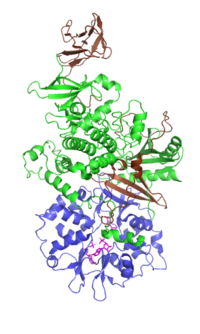
Photo from wikipedia
Lipotoxicity is an important factor in the development and progression of nonalcoholic steatohepatitis. Excessive accumulation of saturated fatty acids can increase the substrates of the mitochondrial electron transport chain in… Click to show full abstract
Lipotoxicity is an important factor in the development and progression of nonalcoholic steatohepatitis. Excessive accumulation of saturated fatty acids can increase the substrates of the mitochondrial electron transport chain in hepatocytes and cause the generation of reactive oxygen species, resulting in oxidative stress, mitochondrial dysfunction, loss of mitochondrial membrane potential, impaired triphosphate (ATP) production, and fracture and fragmentation of mitochondria, which ultimately leads to hepatocellular inflammatory injuries, apoptosis, and necrosis. In this study, we systematically investigated the effects and molecular mechanisms of empagliflozin on lipotoxicity in palmitic acid-treated LO2 cell lines. We found that empagliflozin protected hepatocytes and inhibited palmitic acid-induced lipotoxicity by reducing oxidative stress, improving mitochondrial functions, and attenuating apoptosis and inflammation responses. The mechanistic study indicated that empagliflozin significantly activated adenosine 5’-monophosphate (AMP)-activated protein kinase alpha (AMPKα) through Calcium/Calmodulin dependent protein kinase kinase beta (CAMKK2) instead of liver kinase B1 (LKB1) or TGF-beta activated kinase (TAK1). The activation of empagliflozin on AMPKα not only promoted FoxO3a phosphorylation and thus forkhead box O 3a (FoxO3a) nuclear translocation, but also promoted Nrf2 nuclear translocation. Furthermore, empagliflozin significantly upregulated the expressions of antioxidant enzymes superoxide dismutase (SOD) and HO-1. In addition, empagliflozin did not attenuate lipid accumulation at all. These results indicated that empagliflozin mitigated lipotoxicity in saturated fatty acid-induced hepatocytes, likely by promoting antioxidant defense instead of attenuating lipid accumulation through enhanced FoxO3a and Nrf2 nuclear translocation dependent on the CAMKK2/AMPKα pathway. The CAMKK2/AMPKα pathway might serve as a promising target in treatment of lipotoxicity in nonalcoholic steatohepatitis.
Journal Title: Antioxidants
Year Published: 2022
Link to full text (if available)
Share on Social Media: Sign Up to like & get
recommendations!